Kyrgyzstan # 1 – July/August 2014
Leaving our scenic camp on Lake Karakul, Tajikistan, we climbed up to the Kyzyl-Art pass at 4,336 meters, (14,226 feet) and crossed into Kyrgyzstan. This friendly country did not require a visa for Swiss nor American citizens, so after a quick look at our camper and a stamp in our passports, we were on the road. By comparison to the countries we had been driving through for the past few months, (Georgia, Azerbaijan, Turkmenistan, Uzbekistan, and Tajikistan), the paved highway to Osh was super. OK, there were a few rock-falls. No big deal. Somewhere near the top of Taldyk Pass, 3,615 meters, (11,860 feet), we stopped to help a Dutch couple who were trying to fix a broken fan belt with duct tape. It was not going to work. About that time a guy came on horseback and insisted that Monika take a short ride. It was snowing (July 30!) so she didn’t get far, but it was a beginning for what we came to realize: Kyrgyzstan is a horse country!
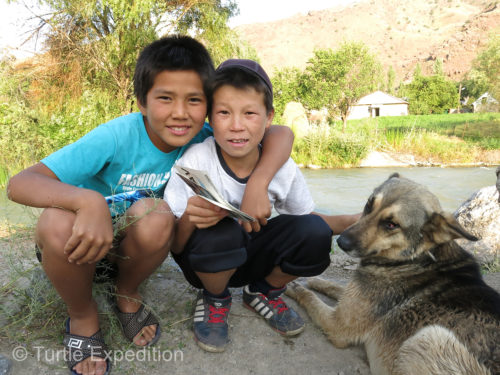
These two friends insisted to have their picture taken and of course, they wanted to see it in the camera.
Remember, we were following the Silk Road, and aside from silk, gemstones, pottery, and spices, one of the important things that was traded along this historic route were horses. Kyrgyzstan horses were famous and probably led to the successful conquests made by Genghis Khan.
Were these the descendants of the famed ‘celestial horses’ sought after by the Emperor Wu of the Han dynasty (July 30, 157 BC – March 29, 87 BC) in order to reinforce the Chinese army against northern nomadic tribes? Was this the horse breed in the Ferghana valley southwest of today’s Kyrgyzstan and southeast of today’s Uzbekistan, a horse known for sweating blood? Well, that could have been a phenomenon caused by a regional parasite, or, a better story, as Marco Polo told it, Genghis Khan’s warriors often had to ride for days without stopping. On such occasions, the rider would cut the horse’s veins and drink the blood that spurted out. Marco Polo reported, perhaps with some exaggeration, that a horseman could, by nourishing himself on his horse’s blood, “ride quite ten-day marches” without eating any cooked food and without lighting a fire.” Because their milk offered additional sustenance during extended military campaigns, a cavalryman usually preferred a few mares among his mounts. The milk was often fermented to produce kumiss, a potent alcoholic drink liberally consumed by the Mongols. In short, as one commander stated, “If the horse dies, I die; if it lives, I survive.” Well, after a good shot of kumiss or vodka.
As we headed downhill, a manner of speaking, a road sign announced Kyrgyzstan with an elevation of 3,550 meters, (11,646 feet), reminding us that the average elevation of this country is 2,750 meters, (9,022 feet) with the Jengish Chokusu peak towering at 7,439 meters, (24,406 feet). The mountains in the distance said it all. Homes were a mix of yurts and Russian style block houses. Kids waved to us as we passed. Horses on the highway were more of a danger than the herds of fat-tail sheep.
We stopped for the night near a small village and were quickly surrounded by friendly boys, all excited about the strange truck. We had to give them a peek inside. One young boy insisted I needed a hat and loaned me his Ak Kalpak.
One of the things the area is famous for, aside from apricots, are their melons, and roadside stands offer more than we could eat. Crossing the wide valleys gave spectacular campsites. The only foreigners we met on this section were a couple of brave Germans on well-equipped road bikes doing the Silk Road the hard way.
Arriving in Osh there was the usual turmoil of city traffic. Following our trusted GPS and a tip from road friends, we headed toward a bridge that would take us through town. To our shock, and no doubt to others, the road narrowed and led us right into the backside of the local market. By the time we realized that we were driving into a can of worms, it was too late to turn around. Backing up would be a disaster. People were scrambling to get their awnings out of our way and helping us inch through the maze of fruit and hardware stands. Well, it could have been a great video, but as is often the case, we had no time to take pictures. Monika was walking ahead to clear the “land mines” and lift overhead ropes. Oh, and the bridge? It was closed to traffic.
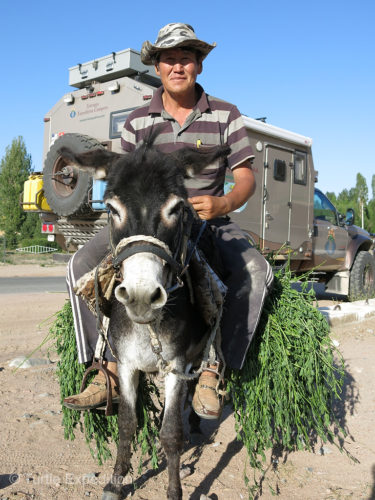
Since Gary had owned a burro when he lived in Mexico as a young boy, he always has a soft spot for these work animals of the world.
Osh is the second largest city in Kyrgyzstan, located in the Ferghana Valley. It is the oldest city in the country (estimated to be more than 3,000 years old). We could have come straight across from Uzbekistan, 5 km away, and bypassed Tajikistan, but that was out of the question. Osh is known for having one of the largest and most crowded outdoor market in Central Asia. It was a major stopping point along the Silk Road and has been named the Great Silk Road Bazar in reference to its historical importance.
No doubt we could have spent days wandering through the Osh bazar, but the clock was ticking. It was the end of July and we had to cross the border into China on August 28—etched in stone. We sped north on good roads toward Bishkek where we found safe but noisy overnight parking at the Togolok Moldo Park. It was close to shops where we could buy a sim card for our cell phone and have the passport photos made that were required for our Chinese visa. (A special size of course. This was China.) We had learned of a can-do visa specialist who assured us a Chinese visa was not a problem. What a relief!! Local busses made it easy to reach another amazing market, interestingly also called the Osh Bazar.
Like all of these sprawling markets, it was a spectacular place to see the local life and culture while shopping for everything from fruit, vegetables, clothing, carpets, cleaning products, bread, flour, seeds, meat, hardware. It didn’t take long to restock our pantry, including some fresh chicken and lamb. We even found a while-you-wait seamstress that sewed a cover for the pad on our third seat which we needed in our truck for our Chinese guide and a sidewalk shoe repair man who was happy to alter the seat belt strap we needed. Monika had fun selecting some silk scarves, unique because wool designs were worked into them. Gary had to buy a coffee cup with a map of the Silk Road on it.
Business taken care of, our Chinese visa would take several days to process, so we headed west to camp on the beautiful Ysyk-Köl lake and to attend the famous Sunday Animal Market in Karakol, the second largest in Central and Western Asia.
- This Kyrgyzstan sign announcing the elevation of 3,550 meters, (11,646 feet), reminding us that the average elevation of this country is 2,750 meters, (9,022 feet).
- The paved highway to Osh was super. OK, there were a few rock-falls. No big deal.
- It was snowing so Monika didn’t get too far on this gentleman’s horse. (July 30!)
- We could imagine what this route looked like a few years ago, or even when camels and horses were the only means of transportation.
- The snowcapped peaks on the horizon left no doubt about the road ahead.
- Yurts were common at higher elevations. This one may have been a rest stop of sorts.
- Kids waved as we passed. Faces were surprisingly different from those in Tajikistan. The Kyrgyz are a Turkic tribe while Tajiks are Indo Europeans.
- These two boys couldn’t stop grinning after we gave them a couple of balloons.
- Yurts were replaced by Russian-style block houses.
- Horses on the highway were more of a danger than the herds of fat-tail sheep. They can spook and move quickly.
- Another road sign. Yes, we were going downhill. 2,389 m/7,837 ft.
- This young Kyrgyz welcomed us to his village.
- We stopped for the night near a small village and were quickly surrounded by friendly boys, all excited about the strange truck.
- The word got out. The whole village must have stopped by to check out the cool The Turtle V.
- These Germans were doing the Silk Road the hard way.
- Wide open camping—sorry, no hook-ups.
- Two people can only eat so much. We had to choose. The area is famous for their melons.
- Our GPS said this was the way, thinking we were driving a Honda Civic. No way to turn around and backing up would be impossible.
- Traffic in Bishkek was tolerable but the efficient system of busses took us wherever we needed to go if it was too far to walk.
- In Bishkek, the capital of Kyrgyzstan, it was easy to get around on busses.
- A tricky bus intersection in Bishkek, Kyrgyzstan.
- The entry into the Osh Bazar was impressive. Zoom in and you will notice that the dress code is very western for both men and women.
- A new butter churn was not on our shopping list.
- Hardware store? If you can’t find it here you probably didn’t need it.
- This young paint salesman gave us a “cool” sign.
- Common cleaning products with Chinese and Russian names. See Mr. Clean at lower right: “Mr. Proper”.
- This woman carding wool had her work cut out for her. Labor is cheap.
- Being a horse country, there were plenty of beautiful saddles for sale.
- Seamstresses were at our service and most repairs could be made while we waited.
- This sidewalk shoe repair man was happy to alter the seat belt strap we needed for the third seat in our truck for our Chinese guide.
- The Kyrgyz are well known for their beautiful boxes. These are typically used for storage and as furniture in yurts which are often moved with the seasons.
- Monika just couldn’t make up her mind. There were so many beautiful silk scarves to choose from.
- Gary had to buy a coffee cup with a map of the Silk Road on it.
- No Monika, this compact washer and dryer will not fit in our truck.
- The selection of dried fruit and nuts was amazing.
- Dried fruit and more dried fruit, nutritious and healthy especially in the winter when fresh fruit might not be available.
- Do we need to remind you that it was apricot season?
- Hungry for fresh black currants or raspberries? Sold by the handful!
- Black currant can be eaten fresh or cooked. It is often used for jellies or syrups. Mixed with (sparkling) water, it is a popular refreshment in Switzerland.
- Maybe we will make some jam or just sprinkle them over cereal or pancakes. My mouth waters just looking at all these juicy raspberries.
- Fresh berries and more fresh berries. I think I want to live here in the summer.
- What? You don’t like black currants or raspberries? How about blackberries or strawberries?
- Worry, worry, worry! What do these people eat? Do we need to bring canned beans?
- We’re stocking up for the road.
- Gary was contemplating buying an Ak Kalpak, a traditional Kyrgyz hat.
- The variety of staples offered was amazing.
- Since people from the countryside come in to buy supplies, you can find huge sacks of any dry goods.
- Very fresh chicken and even fresher lamb.
- It was hard to choose from which vendor to buy!
- Quick, follow that cart loaded with sides of lamb to the butcher stand.
- We decided to pass on what looked like horse sausage.
- Little pastries filled with meat and vegetables and baked on the spot made a good substitute for a Big Mac.
- Fried bread, some covered with honey, were a local favorite.
- Fresh “nan” or “bread” came every day, still warm out of the oven. Each bakery had their own design.
- Big juicy dill pickles were a treat we had not seen before.
- The wonderful sales women in the market were a delight to talk to with Monika’s broken Russian.
- Cell phones have changed the way people react to cameras. Often times, they took pictures of us as well.
- Heading out of town we spotted a neighborhood water faucet and hooked up our handy water thief for a fast fill-up.
- We reached the shore of Ysyk-Köl Lake just in time for the sunset.
- Sunsets at Ysyk-Köl Lake were spectacular.
- Down the beach from our camp we found an abandoned apricot tree just asking to be picked. Did we need more?



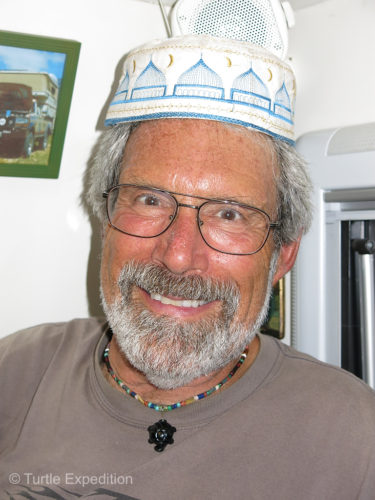
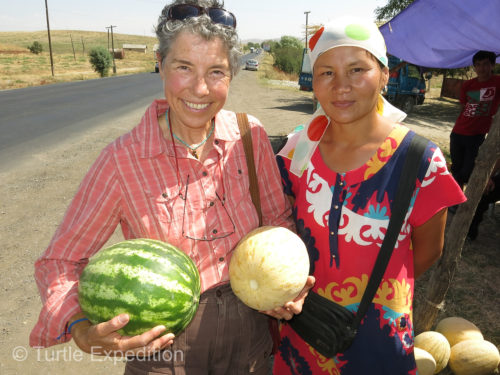
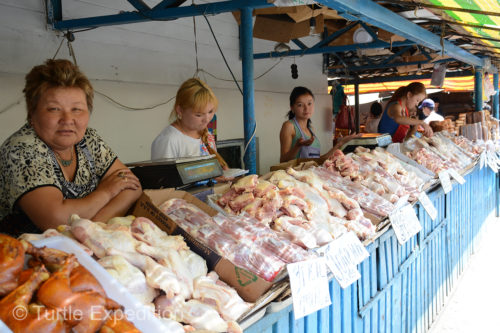
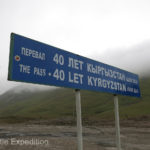
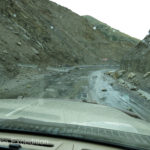
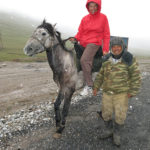
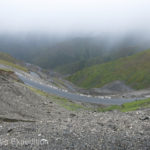
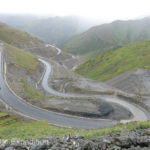
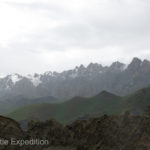
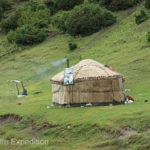
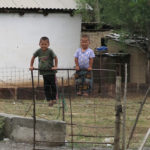
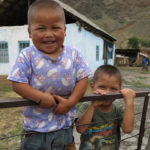
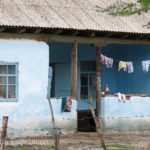
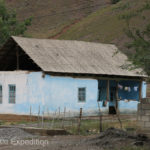
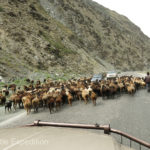
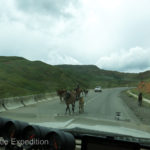
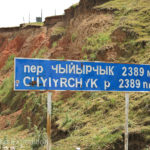
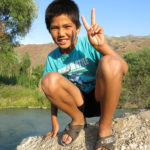
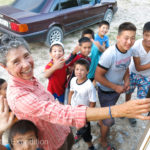
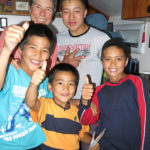
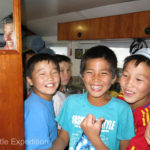
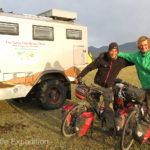
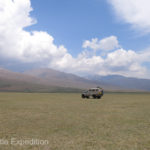
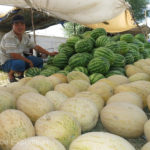
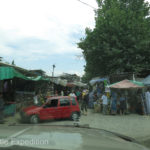
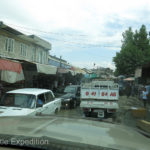
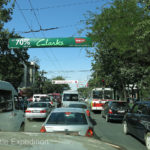
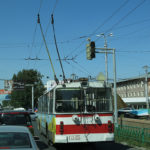
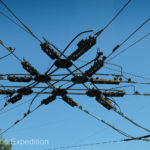
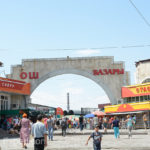
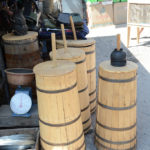
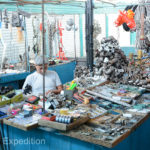
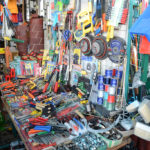
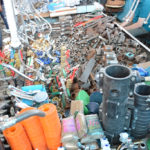
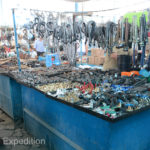
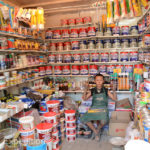

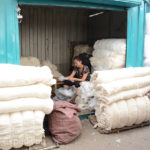
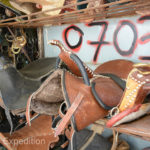
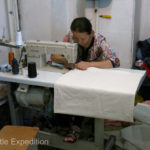
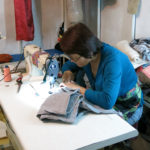
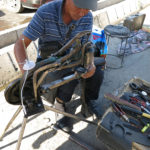
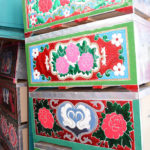
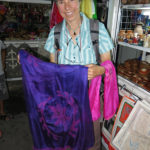
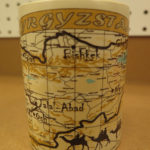
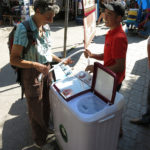
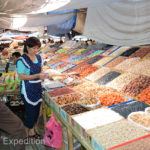
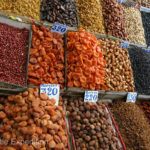
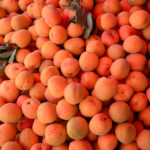
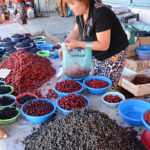
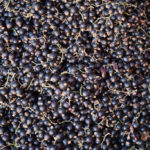
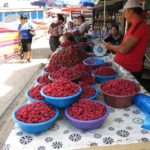
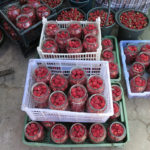
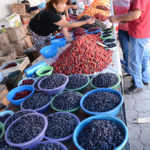
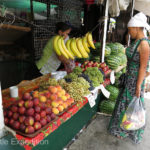
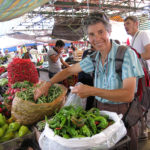
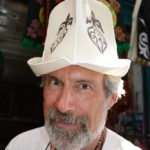
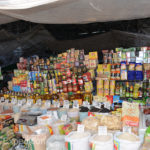
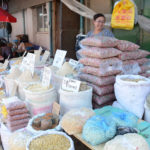
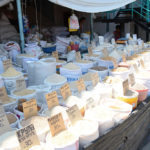
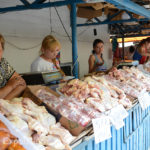
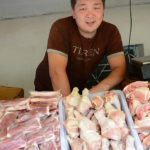
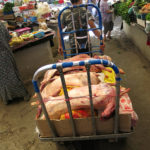
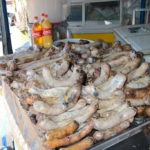
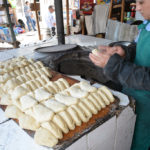
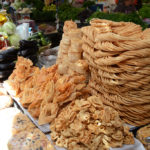
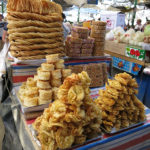
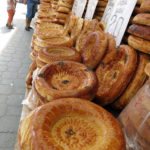
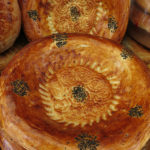
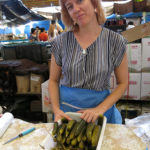
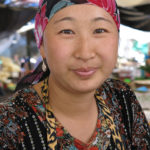
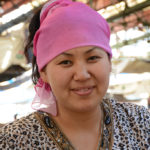

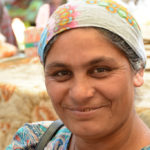
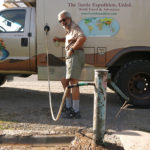
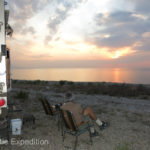
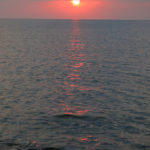
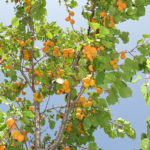





Leave a Comment